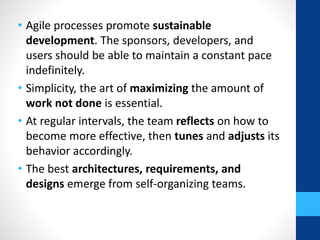Agile Project Development
- 2. ? Information Technology Community A practice in software development. Reaction to various obstacles in PD Latest project management strategies. A specialized area in project management.
- 3. •Also Known As Extreme project management Adaptive project life cycle Change-driven life cycle
- 5. It Promotes adaptive planning evolutionary development early delivery encourages rapid and flexible response to change continuous improvement
- 6. Traditional Vs. Agile Iterative life cycle • Evolve the entire set of deliverables over time, completing them near the end of the project. Waterfall life cycle • It is strictly sequenced: you don’t start design until research is done and you don’t start development until the designs are signed off on • Completes small portions of the deliverables in each delivery cycle. Agile life cycle
- 7. Life Cycle Comparison – oldvs.new Waterfall Life Cycle Agile Life Cycle
- 8. Elements •Tightly Integrated Unit •Frequent Communication •Daily Meetings •Project Backlog •Sprints
- 9. Agile manifesto (values) • Individuals and interactions over processes and tools • Working software over comprehensive documentation • Customer collaboration over contract negotiation • Responding to change over following a plan
- 10. Agile principles • Our highest priority is to satisfy the customer through early and continuous delivery of valuable software. • Deliver working software frequently, from a couple of weeks to a couple of months, with a preference to the shorter timescale. • Business people and developers must work together daily throughout the project. • Welcome changing requirements, even late in development. Agile processes harness change for the customer’s competitive advantage.
- 11. • Build projects around motivated individuals. Give them the environment and support they need, and trust them to get the job done. • Working software is the primary measure of progress. • Continuous attention to technical excellence and good design enhances agility. • The most efficient and effective method of conveying information to and within a development team is face-to-face conversation.
- 12. • Agile processes promote sustainable development. The sponsors, developers, and users should be able to maintain a constant pace indefinitely. • Simplicity, the art of maximizing the amount of work not done is essential. • At regular intervals, the team reflects on how to become more effective, then tunes and adjusts its behavior accordingly. • The best architectures, requirements, and designs emerge from self-organizing teams.
- 13. What do we get? • The end result is a product or project that best meets current customer needs and is delivered with minimal , - costs - waste - time
- 14. It’s different • Speed to market • Flexible agile • Risk management • Cost control • Quality • Right product • Transparency
- 15. Agile Project Manager • Assign tasks • Maintaining values and practices • Removes impediments • Helps to turn the requirements into a working software • Facilitates and encourages effective and open communication • Holds meetings • Enhances the tool and practices used in the development process. • Motivates the team • Plays the role of a mentor and protector to the team • Make decisions on behalf of the team • Involved in technical decision making or deriving the product strategy
- 16. Methodology
- 17. Agile – “An Umbrella” Agile Scrum Feature- Driven Development eXtreme Programming http://www.serena.com/docs/repository/solut ions/intro-to-agile-devel.pdf
- 18. Scrum • Copes up with complexity and risk • Time is divided into short work cadences • No speculations, decision making from real- world results • Inspects and adapts feedback loops • Shippable state at all times • Stakeholders and team members meet to plan its next steps
- 21. eXtreme Programming • Introduce checkpoints • Adopts new customer requirements • Advocates frequent "releases" • Improves productivity, quality and responsiveness
- 22. Conclusion • Traditional project management is insufficient to manage the inevitable change inherent to embedded software projects. Agile project management, however, is well equipped to aid project managers and software development teams in managing risk, scope, budgets, and schedules to create successful, valuable products. • It is everyone's (developers, quality assurance engineers, designers, etc.) responsibility to manage the project to achieve the objectives of the project. • The agile project manager plays a key role.
- 23. Application - Usedin complexprojects. • Intel • Mastek • SME • Shopping cart Scrum at Intel http://scrumtrainingseries.com/Intel-case-study.pdf























